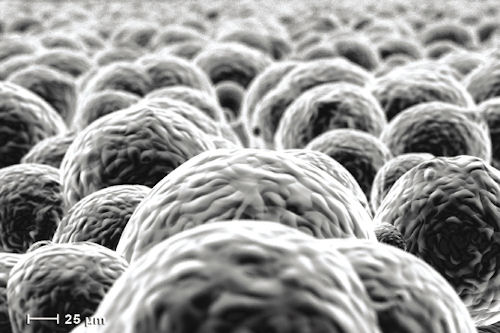Is AM Ready for Standards?
It takes some time for an industry to mature to the point where standards become relevant. That time may be coming soon for additive manufacturing.
Latest News
May 1, 2013
In fact, until recently, there hasn’t been a pressing need for AM standards. For some segments of the market, the capability to print solid objects is so new and so exciting that, especially at the relatively inexpensive end of the spectrum, people just don’t care that much about standards.
“Is the lack of standards impeding our business in any way? No,” asserts Jeff Moe, president of LulzBot, which produces sub-$2,000 desktop 3D printers. “It hasn’t been a pressing issue. From a business perspective—getting our units out there—the lack of standards hasn’t been a problem. A lot of our customers are engineers and architects, and none of them have been asking about standards.”
Any Material You Want, As Long As It’s UV-curable Resin
“Standards are less important for the design end of the market because the bulk of today’s technologies are very different in their capabilities,” says Fred Fischer, director of business development for Stratasys. “The output is so different that it’s relatively easy for someone to make a decision based on that.”
 Artist’s rendering of microscopic view of metal powder particles with an approximate diameter of 150 micrometers ( µm). Renderings copyright Mark Clarkson. |
Fischer uses shopping for a new camera as an example. “If Brand A cameras give you color, and Brand B cameras give you black and white, then it’s easy to make that decision,” he explains. “Do you need color? That’s where our industry is now.”
If you need metal parts, for example, stereolithography (SLA) isn’t an option. If you need transparency, metal laser sintering won’t work. If you need parts 3 ft. wide, you can’t print them with a PolyJet. The physical characteristics of your part—size, material, strength, surface finish, isotropism—will greatly determine which process you’re going to use.
“As the industry continues to mature and the technologies become more like one another, then standards will become increasingly important,” predicts Fischer.
You’re camera shopping again. This time, all the cameras take color photos, but each manufacturer specifies its capabilities differently. One gives resolution in megapixels, another gives the diagonal dimension of the sensor. Frustration and confusion ensue.
Standards solve the problem, but only if we can believe them.
“As you move into functional prototyping or using additive technologies for manufacturing applications,” says Fischer, “the requirement for consistent output becomes critical. If I’m an engineer and I choose a material based upon a material spec sheet, I want the parts I make to come within reasonable proximity of my expectations—not just for the initial part, but on an ongoing basis, from part to part and from system to system.
“Standards help engineers increase their confidence level, and they increase the comprehensiveness of the documentation and data that’s available to help make those decisions,” he continues.
Great. So where are those standards?
ASTM Committee
“The fact that there has been no concerted effort to develop additive manufacturing standards until 2009 is telling,” says Pat Picariello, ASTM International’s director of developmental operations. “No one’s going to invest the time, the effort and the intellectual capital it takes to develop consensus standards unless there’s some return on investment for them.”
But in 2009, ASTM International (formerly the American Society for Testing and Materials), started technical committee F42 to define AM standards. ASTM is an organization that facilitates the development and delivery of international voluntary consensus standards. It is similar to ISO, but with members representing themselves or organizations rather than countries.
 Artist’s rendering of microscopic view of metal powder particles with an approximate diameter of 150 micrometers ( µm). Renderings copyright Mark Clarkson. |
“That there exists an ASTM technical committee on AM speaks to the fact that a good chunk of that industry has decided that standards were ]needed],” says Picariello. “That committee wouldn’t exist otherwise. ASTM doesn’t decide that ‘Today is the day we’re going to start developing standards for a given subject area.’ It’s only the stakeholders, those with a material interest in the topic, who tell us the time’s right and that they’d like ASTM to work with them.”
The membership of F42 consists of more than 150 individuals and organizations from 13 countries, says Picariello. “The membership of any ASTM activity is intended to be a microcosm of the industry it represents. In the case of F42, we have instrument manufacturers, component manufacturers, material suppliers, academicians, different federal entities, and ]consultants.] Each of these individuals, representing one organization or another, works to develop the documents that they decide are relevant at any particular time.”
ISO Committee
There is also an International Organization for Standardization (ISO) AM technical committee: TC 261. TC 261 is even younger than F42, but it has an identical scope and structure—and about an 80% overlap in membership.
“Nobody wants conflicting standards,” says Picariello. “There is an agreement between ASTM International and ISO to work in a collaborative way to develop standards for AM. It sets forth different mechanisms to marry the ISO process to the ASTM process, which will result in a jointly branded ASTM/ISO standard.
“This is the first agreement of its sort between ASTM and ISO,” he adds. “It’s really going to enable the standards development in this area to move at a much more accelerated and collaborative pace.”
Voluntary Servitude
The lack of standards doesn’t mean that, say, aerospace companies aren’t using AM.
“All the prime aerospace contractors have internal process specifications for AM of some kind,” says Shane Collins, business development director of Oxford Performance Materials. “But it’s proprietary to that company, and quite often they see it as a competitive advantage. They may not even want to let on that they’re using AM, let alone help write a standard that could help their competitors get to where they are.”
However reluctantly, additive manufacturers are waking up to the need for standards to facilitate everyday transactions between buyers and sellers. Even so, AM standards aren’t exactly developing at breakneck speed.
“It’s really hard to get worldwide consensus on anything,” Collins quips.
At press time, ASTM F42 has published five standards to date: two on terminology, one on a new file format, and two for very specific manufacturing processes.
It’s important to note that participation in the ASTM or ISO technical committees is entirely voluntary—it’s not a paying job.
“It takes the commitment of people who have day jobs to write these standards,” says Collins. “These people usually already have a full plate, especially the talented people who we need to dedicate time to this.”
Supply and Demand
Despite all difficulties, the consensus remains that having AM standards in place is only a matter of time.
“All of your Tier 1 guys have written their own standards,” says Collins, “and they’ve coddled their supply chain for additive so far. But we’re getting to the point where their supply chain is going to be several steps removed. When their supplier’s supplier’s supplier starts supplying additive parts, and they lose track of the fact that the part was made additively, and now it’s become a part of a larger assembly—that will be an OMG moment.
“That’s when the problems will appear, and they’ll recognize the need for standards.”
Contributing Editor Mark Clarkson is DE’s expert in visualization, computer animation, and graphics. His newest book is Photoshop Elements by Example. Visit him on the web at MarkClarkson.com or send e-mail about this article to [email protected].
More Information
Subscribe to our FREE magazine, FREE email newsletters or both!
Latest News
About the Author
Mark ClarksonContributing Editor Mark Clarkson is Digital Engineering’s expert in visualization, computer animation, and graphics. His newest book is Photoshop Elements by Example. Visit him on the web at MarkClarkson.com or send e-mail about this article to [email protected].
Follow DE





